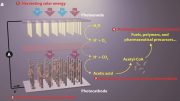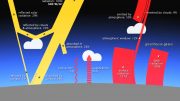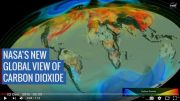
A new study finds that plants are photosynthesizing more in response to more carbon dioxide in the atmosphere, but nowhere near enough to remove all emissions.
Plants Buy Us Time to Slow Climate Change – But Not Enough to Stop It
New research from Berkeley Lab and UC Berkeley shows that plants are photosynthesizing more in response to more carbon dioxide in the atmosphere.
Because plants take up carbon dioxide from the atmosphere and convert it into food, forests and other similar ecosystems are considered to be some of the planet’s most important carbon sinks. In fact, the United States and many other countries that participated in last month’s UN Climate Change Conference have made nature-based solutions a critical feature of their carbon dioxide mitigation framework under the Paris Agreement.
As human activities cause more carbon dioxide to be emitted into the atmosphere, scientists have debated whether plants are responding by photosynthesizing more and sucking up even more carbon dioxide than they already do – and if so, is it a little or a lot more. Now an international team of researchers led by Lawrence Berkeley National Laboratory (Berkeley Lab) and UC Berkeley have used a novel methodology combining remote sensing, machine learning, and terrestrial biosphere models to find that plants are indeed photosynthesizing more, to the tune of 12% higher global photosynthesis from 1982 to 2020. In that same time period, global carbon dioxide concentrations in the atmosphere grew about 17%, from 360 parts per million (ppm) to 420 ppm.
The 12% increase in photosynthesis translates to 14 petagrams of additional carbon taken out of the atmosphere by plants each year, roughly the equivalent of the carbon emitted worldwide from burning fossil fuels in 2020 alone. Not all of the carbon taken out of the atmosphere through photosynthesis is stored in ecosystems, as much is later released back to the atmosphere through respiration, but the study reports a direct link between the increased photosynthesis and increased global carbon storage. The study was published in Nature.
“This is a very large increase in photosynthesis, but it’s nowhere close to removing the amount of carbon dioxide we’re putting into the atmosphere,” said Berkeley Lab scientist Trevor Keenan, lead author of the study. “It’s not stopping climate change by any means, but it is helping us slow it down.”
Measuring photosynthesis
Because carbon dioxide stays in the atmosphere decades longer than other greenhouse gases driving global warming, efforts to reduce it are critical to mitigating climate change. Plants, through photosynthesis, and soils sequester roughly a third of carbon dioxide emissions released into the atmosphere each decade from the burning of fossil fuels.
During photosynthesis, plants open tiny pores on their leaf surfaces to suck carbon dioxide from the air and produce their own food. To measure this photosynthetic activity, scientists can put a leaf in a closed chamber and quantify the dropping carbon dioxide levels in the air inside. But it’s far more difficult to measure how much carbon dioxide an entire forest takes up.
Through initiatives such as AmeriFlux, a network of measurement sites coordinated by the Department of Energy’s AmeriFlux Management Project at Berkeley Lab, scientists from across the world have built over 500 micrometeorological towers in forests and other ecosystems to measure the exchange of greenhouse gases between the atmosphere and the vegetation and soil. While these flux towers can help estimate photosynthesis rates, they’re expensive and thus limited in their geographic coverage, and few have been deployed long-term.
This explains why scientists rely on satellite images to map how much of the Earth is green and thus covered by plants, which allows them to infer global photosynthetic activity. But with rising carbon dioxide emissions, those estimates based solely on greenness become problematic.
Bringing history in the picture
Satellite images can capture the extra green to account for additional leaves plants put out due to accelerated growth. But they often don’t account for each leaf’s increased efficiency to photosynthesize. Also, this efficiency doesn’t increase at the same rate at which carbon dioxide builds up in the atmosphere.
Previous efforts to estimate how photosynthesis rates respond to increased carbon dioxide concentrations found widely varying results, from little to no effects on the low end, to very large effects on the high end.
“That magnitude is really important to understand,” said Keenan, who is also an assistant professor in UC Berkeley’s Department of Environmental Science, Policy and Management. “If the increase [in photosynthesis] is small, then we may not have the carbon sink we expect.”
So Keenan and his team of researchers took a new approach: they looked back at nearly three decades of carbon sink estimates made by the Global Carbon Project. They compared these with predictions from satellite images of the Earth taken between 1982 and 2012 and models using carbon exchange between the atmosphere and land to make carbon sink estimates.
“Our estimate of a 12% increase comes right in the middle of the other estimates,” he said. “And in the process of generating our estimate, it allowed us to re-examine the other estimates and understand why they were overly large or small. That gave us confidence in our results.”
While this study highlights the importance of protecting ecosystems that are currently helping slow down the rate of climate change, Keenan notes that it’s unclear how long forests will continue to perform this service.
“We don’t know what the future will hold as far as how plants will continue to respond to increasing carbon dioxide,” he said. “We expect it will saturate at some point, but we don’t know when or to what degree. At that point land sinks will have a much lower capacity to offset our emissions. And land sinks are currently the only nature-based solution that we have in our toolkit to combat climate change.”
Reference: “A constraint on historic growth in global photosynthesis due to increasing CO2” by T. F. Keenan, X. Luo, M. G. De Kauwe, B. E. Medlyn, I. C. Prentice, B. D. Stocker, N. G. Smith, C. Terrer, H. Wang, Y. Zhang and S. Zhou, 8 December 2021, Nature.
DOI: 10.1038/s41586-021-04096-9
The study was supported in part by NASA and the DOE Office of Science. Among the co-authors were Berkeley Lab postdoctoral fellows Nicholas Smith, Yao Zhang, Xiangzhong Luo, and Sha Zhou, all now at other institutions.









“Our estimate of a 12% increase comes right in the middle of the other estimates,”
Yes, this isn’t really news. NASA and others using satellite data have been reporting on the global greening for a few years now.
I find it interesting that CO2 is acknowledged to be increasing the efficiency of photosynthesis (increasing food production) and expanding the range of plants (decreasing desertification), and it is viewed as being bad. personally, I see these as being desirable! I think that the authors are demonstrating myopia. They only see the global greening in the context of reducing the thing that they implicitly admit has benefits.
There are usually tradeoffs in life and one has to make subjective decisions about the tradeoffs. As an example, some of the ways to improve the gas mileage of a vehicle usually result in decreased performance. One can only carry that so far before the purpose of the vehicle is seriously compromised.
I think that if these researchers are going to interject their subjective opinions they need to examine their assumptions and priorities. A rigorous cost-benefit analysis would be a good place to start.
Your subjective opinion on that scientist opinionate instead of reporting objective facts do not impress since already the article shows you wrong. It also conflicts with your cherry picked acceptance of the reported science.
There are many cost-benefit analyses out there already, and we know that resources is now best spent to decrease man made global warming instead of adapting to it. So yes, the changes are already too large to be anything but bad. And you would know this if you read up on the topic. It’s all over the place so I leave your own web search to it.
This article warns against seeing these changes as desirable for ever. We expect 3-4 degC temperature increase if your embracing it as desirable had its way, and our food crops are optimized for the current regional climates and will start to drop in productivity even at higher CO2. This too is returned by web search, though you may need help finding the exact references.
The problem with any biological sequestration of CO2 is the fact that eventually the biomass will be recycled by the oxygen it created…aerobic respiration. To make that capture permanent requires geological burial. Nature did it and it took million of years. Humans cannot hope to duplicate that even to a small extent.
As as already been pointed out, any greening of the planet should be viewed as positive and optimistic, while so many are pessimistic and worried about CO2 destroying the planet that they want to reach s net-zero emission goal, spending tons of money trying.
You mean getting returns on money spent, since it is cheaper to do something about man made global warming than letting it proceed since a few years back.
Cherry pick science all you want, the conclusion remains that we need to do something about the process we are causing.
“Climate change is affecting food security. It has caused reduction in global mean yields of maize, wheat, and soybeans between 1981 and 2010.[187] Future warming could further reduce global yields of major crops.[188] Crop production will probably be negatively affected in low-latitude countries, while effects at northern latitudes may be positive or negative.[189] Up to an additional 183 million people worldwide, particularly those with lower incomes, are at risk of hunger as a consequence of these impacts.[190] The effects of warming on the oceans impact fish stocks, with a global decline in the maximum catch potential. Only polar stocks are showing an increased potential.[191] Regions dependent on glacier water, regions that are already dry, and small islands are at increased risk of water stress due to climate change.[192]
Livelihoods
Economic damages due to climate change may be severe and there is a probability of disastrous tail-risk events.[193] Climate change has likely already increased global economic inequality, and this trend is projected to continue.[194] Most of the severe impacts are expected in sub-Saharan Africa and South-East Asia, where existing poverty is already exacerbated.[195] The World Bank estimates that climate change could drive over 120 million people into poverty by 2030.[196] Current inequalities between men and women, between rich and poor, and between different ethnicities have been observed to worsen as a consequence of climate variability and climate change.[197] An expert elicitation concluded that the role of climate change in armed conflict has been small compared to factors such as socio-economic inequality and state capabilities, but that future warming will bring increasing risks.[198]”
[“Climate change”, Wikipedia]
If climate change is driving poverty, it likely generates less returns than before.
Accept the good news & forget about the gathered tyrants at the UN.
First, what would be the “good” news? Second, what would be the “tyrants” and what would that have to do with plant CO2 absorption?
UN houses most nations, and most nations are democratic. There seems to be no list of current tyrants, but 50 of the world ~ 200 nations are estimated “not free”:
“Country ratings for 2016 from Freedom House’s Freedom in the World 2017[14]
Free (86) Partly Free (59) Not Free (50)”
[ Figure text in https://en.wikipedia.org/wiki/Dictator#Modern_era ]
Being that climate change is natural and isn’t a problem at all, there really isn’t anything to be concerned about. This being a “scientific” site, I’m sure you already know that.